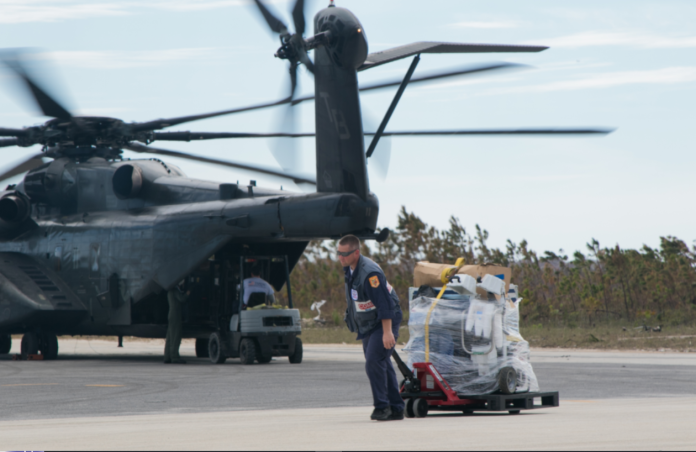By SHARON BURKE AND ANDREA H. CAMERON
The U.S. Department of Defense spends many millions of dollars on wargaming every year. For anyone who has participated in such games, the recent news about Taiwan might provoke an uncomfortable sense of déjà vu. The sequence of events — a visit by a prominent American politician, aggressive People’s Liberation Army posturing, and a U.S. freedom of navigation exercise in the Taiwan Strait — are ones we’ve played out before. And the next move is usually nothing good.
Yet the real-life scenario has already gone off script in some unexpected ways. For one thing, the Chinese government has been dealing with domestic crises that are rarely part of military games — the pandemic, but also record heat and drought, which killed hundreds of people and caused rolling brownouts from desiccated dams. Seasonal rains promised some relief, but also caused flooding, though nothing like the catastrophic situation in neighboring Pakistan.
These are significant events shaping China’s choices, but to date, the Pentagon has not really incorporated how climate change may affect strategic competition into wargaming. That may be about to change, however. Since October 2021, when the Secretary of Defense directed all defense components to include climate change in strategy and plans, the U.S. Department of Defense has conducted three climate change-focused scenario exercises. According to the Joint Staff’s Principal Director for Logistics, U.S. Africa Command, U.S. Central Command, U.S. Europe Command, U.S. Indo-Pacific Command, and the Joint Staff Logistics Directorate are all planning for more.
These games can play a valuable role in helping national security actors anticipate strategic surprises and understand a changing threat landscape. To date, climate change governance in the United States has been wholly inadequate, in part because of how difficult it is to imagine future conditions in a way that can credibly inform decisions, investments, and difficult tradeoffs in the present. Scenario exercises can give both civilian and defense organizations a way to close that imagination gap and better prepare for the way climate change will shape a discontinuous future security environment.
To get the most out of climate change wargames, planners should heed some lessons from the Pentagon’s initial forays into this field. First, climate change is the ultimate systems-level challenge, so it is easy to overreach. Games that try to be about everything can end up being about nothing. Too many sponsors or stakeholders with different agendas can make for incoherent outcomes. Second, it is tempting to focus these games on disasters — the most obvious consequences of climate change — but that tends to produce insights about disaster response rather than climate change. For example, climate change dramatically worsened the scale and scope of Pakistan’s floods in ways that are strategically significant, both in terms of the stability of a nuclear-armed state and of China’s very public show of support for the erstwhile U.S. ally. But if a game focused on how to help Pakistan manage the emergency humanitarian response or disaster recovery, the findings would have more to do with relief and recovery missions than the way climate change may be raising strategic risks. Third, more can be done to build overlapping expertise between wargaming experts and climate experts with an eye toward bettering red-teaming climate change. Finally, climate games to date have focused more broadly on creating familiarity with the security angle to this geophysical phenomenon. It is time to move on to games that answer specific policy, planning, strategy, or budgetary questions. These could include exploring how climate change might shape strategic competition with China or modeling investments in resilience for bases that directly support military operations.
Initial Steps
The Department of Defense describes climate change as a “shaping threat,” one that affects the geostrategic, operational, and tactical environments, with significant implications for U.S. national security and defense. That broad scope of security risk can boil down to three key, gameable questions for military organizations: How will climate change affect global stability within and across national borders? How will climate change directly shape military missions? How will a changing operating environment affect military readiness?
Although there are many high-quality, reliable climate science models, there is insufficient actionable analysis to answer these three basic questions. Wargaming or scenario exercises offer a rigorous methodology for characterizing impacts, testing ideas about preparation and response, developing institutional capacity, and prioritizing investments, all without minimizing the uncertainties and complexity inherent in climate change. Such exercises can also help clarify what information organizations need in order to better budget, program, and plan.
To date, most climate change scenario exercises have been informational and educational in nature, with a core goal of increasing familiarity in target audiences. The Center for a New American Security held one of the first major climate wargames in 2008, which centered around climate security and international negotiations. Soon after that, the Center for Naval Analysis, a federally funded research and development center, built similar games more oriented toward food security for a group of non-governmental organizations. The United Nations Climate Security Mechanism sponsored a participatory, seminar-style climate security scenario exercise in September 2021 designed to educate attendees on the relevance of climate change to their work across United Nations programs. Two other international think tanks held climate security games in 2021 and 2022: Berlin-based adelphi and the Hague Center for Strategic Studies, both explicitly for the purpose of raising awareness.
While the first climate change wargame at the Department of Defense, Elliptic Thunder, was also aimed at generating climate literacy, it had a more targeted purpose. It was held in March 2021 and led by the Office of the Secretary of Defense and U.S. Africa Command in cooperation with designers on the Joint Staff. The intent of this game appears to have been to highlight to an internal audience how climate change constitutes a national security concern with relevance to the defense mission. Although the details are classified, the multi-move tabletop exercise used a future scenario in East Africa, projecting how climate change may affect state stability, violent extremist organizations, mass migration, and other security factors. Precipitous Storm, a second tabletop exercise in 2022, followed a similar design, with the U.S. Southern Command and U.S. Northern Command exploring a scenario in Central America and the Caribbean. Based on the authors’ conversations with participants, the games produced several key takeaways: Engaging in climate adaptation measures today is essential to be prepared in the future; the Department of Defense needs to consider the relevance and possible primacy of other civilian governmental agencies; malign actors may use climate disorder as a way to gain influence; and the Department of Defense needs to refine its processes, budget, and planning to address climate change. The games also clarified that climate change is a context in which events are happening (a “shaping threat”) rather than a competitor with the agency (a “pacing threat”).
In June 2022, the Department of the Navy, under the leadership of Assistant Secretary for Energy, Installations, and Environment Meredith Berger, conducted a similar game, designed by the Marine Corps Warfighting Laboratory. During the half-day, unclassified seminar-style tabletop exercise, in which both authors participated, players from external organizations, along with Marine Corps and Navy senior mentors, broke into three cells to consider how to react to a future scenario that revolved around a typhoon. The main goal of the exercise was to raise awareness about the scope and scale of the security impacts of climate change, but it also incorporated the geopolitical context. To do this, the scenario had one fictional country using Washington’s reaction to the typhoon as a source of disinformation in order to cultivate local support.
Lessons Learned
Despite their value, these exercises have illuminated a number of challenges for successfully wargaming climate change. First, climate change is a sprawling, complex topic, and there is considerable ambiguity about how it will impact national security. This can be a significant design problem when it comes to isolating suitable questions for inquiry. As a result, games have sometimes been a bit muddy or overly general. This lack of clarity has been compounded by the fact that climate change is an inherently interdisciplinary subject that combines the difficulty of understanding both geophysical phenomena and human systems as they interact with each other. As a result, some of the games played to date have suffered from a diversity of sponsors or players with various competing queries or priorities.
On the other hand, efforts to isolate a key question can also backfire. Designers tend to gravitate toward natural disasters, such as droughts or hurricanes. The Department of Defense has been doing humanitarian assistance and disaster relief exercises for more than 20 years and has well-established authorities, doctrine, funding lines, and training, as well as relationships with the U.S. Agency for International Development and the Federal Emergency Management Agency. For those leading Department of Defense disaster relief missions, it is largely irrelevant whether a natural disaster is a climate change-related or not. While climate change may shift the frequency of such missions, this can get lost in the focus on a specific disaster scenario. Climate wargames are a great opportunity to intentionally open the aperture for the broader set of climate questions beyond disaster response.
Then there is the problem of expertise. Wargaming experts are not always familiar with climate change and climate change experts aren’t always familiar with wargaming. Improving climate literacy will help all involved maximize the potential for analysis from climate wargaming. Some venerable wargaming professionals may suggest that wargaming is not an appropriate tool because you cannot “red team” climate change. However, climate change wargames have already shown a variety of ways to integrate climate change considerations in wargaming, with or without red teams. A scenario can involve two actors whose interactions are shaped by climate, for example having climate-related instability pull both the United States and China further into a given region. Alternatively, climate change itself can be the red team. In this approach, the decisions that the blue team makes will have probabilistic outcomes that can be gamed to inform the next move, such as having a drought worsen after U.S. forces have intervened in a country. Climate change can also act as a forcing function that increases or decreases demand on a particular capability or skill or stresses the operating environment in a way that causes the blue team to reconsider options. While climate change may not be a red team decision-making actor, the wargaming community should start exploring the variety of ways climate can be incorporated.
Key Questions to Game
As military organizations consider how to institutionalize climate security questions into their operations, plans, strategies, and programs, wargames can help by concentrating on the gaps that climate change creates in these areas. Game sponsors should focus on direct ties between climate impact and organizations, such as insufficient authorities and resources, policy gaps, seam issues, requirements determination, bureaucratic hurdles, required interagency connections, operational adaptation, and missing capabilities.
Climate change wargaming can also help address other questions. For example, wargamers can analyze how climate change will affect strategic competition, including between the United States and China, and how in turn that competition may play a role in climate change response. That leads to a range of gameable questions: How can state competitors exploit a climate-related vulnerability? How might nations compete for influence through infrastructure development, foreign aid, humanitarian assistance, or access to critical minerals and renewable energy? How might competitors exploit the gray zone or use hybrid warfare tactics in conjunction with climate vulnerabilities? And how might climate change shape partnerships and alliances, whether by leaving some partners more vulnerable or forcing organizations like NATO to curtail their use of fossil fuels? Wargames can also examine the consequences of specific strategies for climate change mitigation or adaptation. For example, the U.S. Army Climate Strategy sets a goal to “achieve 50 percent reduction in Army net greenhouse gas pollution by 2030.” Wargames can analyze the operational impacts of various approaches to meeting this goal.
Climate-to-conflict pathways also call for extensive and rigorous analysis. Here, blue team/red team wargaming could bring out a series of rational choices along a pathway that potentially heightens tensions. This can be used to look at a range of instability scenarios including water, food, or energy shortages as well as mass migration. It would have been prudent, for example, to game out the potential consequences of a mass casualty disaster and displacement in a nuclear-armed state before the recent catastrophe in Pakistan or options for dealing with energy blackmail from Russia or other major oil and gas producers during the energy transition.
Another approach is to forecast a known climate hazard into an out-year and ask: If this event is going to happen in the future, what would you do to prepare now? This approach can help policymakers understand how to prevent or prepare for international instability or how to prioritize investments in installation resilience, including infrastructure such as overseas ports. Wargames can also analyze non-climate-related foreign policy action and see how it holds up against climate change, such as relationships with allies and partners. Finally, wargames can look at the effects of a key tipping point — either climate-related or social — on a country or organization. For example, melting ice in the Arctic and elsewhere may be slowing down ocean currents or spawn polar vortices. These changes, in turn, can lead to more severe winters in Europe. Consider that, with regard to the upcoming winter, this will likely intensify the humanitarian and strategic effects of Russian war in Ukraine.
The Department of Defense should address these questions as it engages in climate-focused wargaming and incorporates climate change into other wargames. At the same time, many of the most important questions about climate change — such as how to promote the transition to carbon-free economic development — are not the responsibility of the armed forces. Ideally, military climate gaming can nonetheless play a leading role in improving interagency cooperation. While wargaming or scenario exercises are not as common at the State Department or U.S. Agency for International Development, civilian agencies and civil society could also benefit from them. Any organization grappling with climate change decisions should consider using this analytical tool to inform its decision-making.
Authors: Sharon Burke is the president of Ecospherics. She is a former assistant secretary of defense. CDR Andrea H. Cameron, Ph.D., is a professor at the Naval War College. This article is adapted from the report of the Climate Wargaming Working Group, chaired by Sharon Burke, at Connections, the annual wargaming conference held in Alexandria, Virginia, in July 2022.





